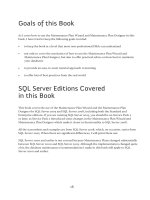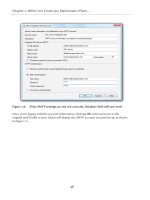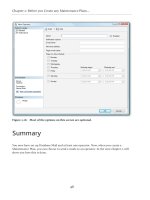Brad’s Sure Guide to SQL Server Maintenance Plans- P10 pot
Bạn đang xem bản rút gọn của tài liệu. Xem và tải ngay bản đầy đủ của tài liệu tại đây (561.04 KB, 5 trang )
Chapter 2: Before you Create any Maintenance Plans…
46
Figure 2.16: Most of the options on this screen are optional.
Summary
You now have set up Database Mail and at least one operator. Now, when you create a
Maintenance Plan, you can choose to send e-mails to an operator. In the next chapter, I will
show you how this is done.
47
Chapter 3: Getting Started with
the Maintenance Plan Wizard
Now that we have all the preliminaries out of the way, we can focus on how to create a
Maintenance Plan using the Maintenance Plan Wizard. The marketing story behind the
Wizard is "answer a few simple questions on some screens, and voilà, you have a working
Maintenance Plan." Of course, the reality is not quite that simple.
While the Wizard does present various configuration options, it does not explain what they
do, or their pros and cons. There is also no way to determine if the options you choose are
even applicable to your situation.
This chapter will provide a quick overview of the entire process of creating a Maintenance
Plan from start to finish, using the Wizard. I'll cover preparation, how to start, and how
to navigate through and complete the Wizard, using an example Maintenance Plan that
implements the core database maintenance tasks identified in Chapter 1.
I won't be going into a lot of detail this time around. Instead, I will save the detail for
later chapters, which will show you how to implement each individual task, from database
integrity checking to reorganizing indexes and updating statistics, and cover every
possible option available. As we progress through this and subsequent chapters, I'll try to
anticipate and answer your likely questions, and offer lots of advice and best practices on
database maintenance.
So, while this chapter will get you started, it is just a beginning. We still have a lot of hard
work ahead before you know everything there is to know about using the Maintenance
Plan Wizard.
Finally, before we start, I will remind you again here, as I will be reminding you throughout
this book: a Maintenance Plan created with the Maintenance Plan Wizard or Maintenance
Plan Designer provides only the core components of a SQL Server database maintenance
plan. As discussed in Chapter 1, there are additional database maintenance tasks, which you
must do outside of a Maintenance Plan created using the Wizard.
Chapter 3: Getting Started with the Maintenance Plan Wizard
48
Exploiting the Full Potential of the
Wizard
If you decide to use the Maintenance Plan Wizard to create Maintenance Plans for a given
server or set of servers, my advice would be to take advantage of as many of its features as you
can. The Wizard allows you to perform the core database maintenance tasks using one tool,
and you might as well get all of the benefits the tools provides, such as the ease of setup.
I suggest that you avoid thinking that you'll use some of the features available in the Wizard,
but perform other tasks using T-SQL or PowerShell scripts. Instead, pick one or the other,
for a given server, or set of servers, and stick with it. For all the examples in this chapter and
this book, I am going to assume that you will be taking maximum advantage of the features
available to you from the Maintenance Plan Wizard.
Investigating Existing Maintenance
Plans
Before you create a new Maintenance Plan, it is a good idea to first check to see if there
are any existing Maintenance Plans, and find out what they do. This way, you can avoid
inadvertently creating a new Maintenance Plan that includes tasks that overlap with an
existing plan.
To find out if there are any existing Maintenance Plans, open SSMS, select the relevant SQL
Server instance, and then click on the Management folder. The contents of the Management
folder vary between SQL Server 2005 and SQL Server 2008. However, in either version, any
current plans will be stored in the Maintenance Plans subfolder. If it's empty, it means there
aren't any. Otherwise, you will see a list of one or more Maintenance Plans, as shown in
Figure 3.1.
If there are any Maintenance Plans, you will want to check them out to see if they are
performing as you expect. If they are, then you may not need to create new ones. On the
other hand, if the existing Maintenance Plans are poorly designed, or don't perform all the
tasks you want them to perform, then you may want to delete them and start from scratch.
Often, starting over is easier to than trying to fix ill-conceived Maintenance Plans.
Chapter 3: Getting Started with the Maintenance Plan Wizard
49
Figure 3.1: This example shows two existing Maintenance Plans.
Chapter 19 demonstrates how to view and modify the contents of an existing Maintenance
Plan, using the Maintenance Plan Designer.
Privileges required for managing Maintenance Plans
In order to view Maintenance Plans from within SSMS, or to create or modify them, you
have to be a member of the sysadmin fixed server role.
For now, let's assume that there aren't any existing Maintenance Plans and that you want to
create a new one.
Chapter 3: Getting Started with the Maintenance Plan Wizard
50
Creating a Maintenance Plan
In this section, I'll walk through all the Wizard steps required to create a Maintenance Plan
that will perform all of the "core" database maintenance tasks identified in Chapter 1.
Starting the Maintenance Plan Wizard
When I use the Maintenance Plan Wizard to create a new Maintenance Plan, I often goof up
and choose the wrong option. Hopefully, I can help you avoid this bad habit by teaching you
how to do things correctly from the beginning.
To start the Maintenance Plan Wizard, open SSMS and navigate to the Maintenance Plans
folder of the relevant server (as shown in Figure 3.1) and right-click on this folder to reveal the
pop-up menu shown in Figure 3.2.
Figure 3.2: Choose Maintenance Plan Wizard from the menu.
The mistake I almost always make is to select the New Maintenance Plan… option. I think
I do this because I instinctively know that my goal is to create a new Maintenance Plan, and
the first option looks like it will work. Actually, it will work, but not as expected. The New
Maintenance Plan menu option will start the Maintenance Plan Designer. Instead, select
Maintenance Plan Wizard, which is the way to start the Wizard.









